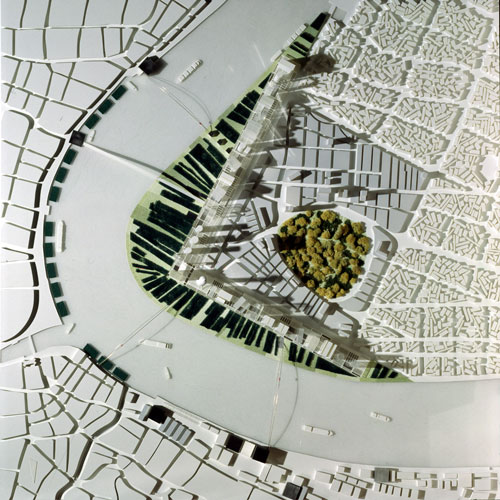ghhhhhhh
Proyecto: Lu Jia Zui Business Centre
Arquitecto: DPA: Dominique Perrault Architecture
Situación: Shanghái, República Popular China
Superficie terreno: 4.000.000 m2
Estado: Proyecto
Fecha proyecto: 1992
Cliente: City of Shangai
El estudio para el desarrollo de un centro de negocios en Shanghai, situado en el distrito Lu Jia Zui es una de las grandes reflexiones urbanísticas de nuestros tiempos.
Nuestro enfoque se basa en las lecciones de la historia, sin excluir todos los factores positivos relacionados con la construcción de las ciudades, ya sean antiguas, modernas o contemporáneas.
En un principio, es necesario realizar una lectura histórica de la distribución de la ciudad. Esto demuestra que Shanghai se define por las rutas de Norte a Sur y de Este a Oeste, formando un tejido relativamente ortogonal. Este factor determina la orientación general de las redes de la nueva zona para que pueda ser, naturalmente, con la ciudad existente, y, además, a una comparación con otras ciudades que proporcionan elementos de referencia para evaluar el alcance y las necesidades del proyecto.
El análisis histórico y funcional de la ciudad no puede dar cuenta de la dimensión simbólica del «acontecimiento fundador», que debe inscribir el nuevo barrio en el paisaje de la ciudad.
Este «acontecimiento fundador» debe marcar el desarrollo del centro histórico de la ciudad, de cruzar a la otra orilla, que tiene una nueva identidad para el «corazón de Shanghai», mediante el establecimiento de una nueva relación entre la ciudad y la naturaleza. Frente al río Bund, después de su deambular, se propone establecer una línea de trazos en ángulo recto, de norte a sur y de este a oeste. Esta forma de aislamiento y único es el contrapunto a la arquitectura en la otra orilla. Se ofrece un gran parque en la orilla del agua, y su conjunto de rascacielos actúan como un soporte para el desarrollo de Shanghai hacia el este.
Al igual que un surco en un campo, esta escuadra sigue el plan de la nueva ciudad. Habrá espacio para dos millones de metros cuadrados de oficinas, áreas de actividad o de comercio y, por debajo de ellos, habrá una red de carreteras para los coches, aparcamientos y dos túneles adicionales uniendo las dos orillas.
Todo el proyecto está diseñado en términos de duración, del paso del tiempo, de la lenta creación de paisaje de nuestras ciudades. Esta investigación podría ser llamada «Hacia un urbanismo de vida,» más interesado en el vacío. Debemos proteger el vacío, que es la posesión más preciada de la ciudad, que permite la creación de plazas, garantiza el futuro de nuestras ciudades, garantiza la presencia de la naturaleza. El vacío es inmaterial, no es nada, sin embargo, constituye «el fundamento de nuestros pueblos.» Todas nuestras relaciones, nuestras miradas y nuestras esperanzas, se establecen a través del vacío.
The study for the development of a major business district in Shanghai in the Lu Jia Zui district in Pudong is one of the great urbanistic reflections of our times. Our approach draws on the lessons of history, without excluding all the positive factors concerning the building of cities, whether they are ancient, modern or contemporary. At the outset, it is necessary to perform a historic reading of the city’s layout.
This shows that Shanghai is defined by routes running from North to South and from East to West, forming a relatively orthogonal fabric. This factor determines the general orientation of the networks of the new district so that it can be naturally linked to the existing city, and furthermore, to a comparison with other cities which provide elements of reference in order to assess the scope and needs of the project. The historical and functional analysis of the city cannot give account of the symbolical dimension of the «founding event» which must inscribe the new district within the landscape of the city. This «founding event» ‘must mark the development of the historic city center, of crossing over to the other bank which holds a new identity for the «heart of Shanghai» by establishing another relationship between Town and Nature. Opposite the river Bund, following its meander, we propose a broken line set at right angle, facing from north to south and from east to west.
This solitary and unique form is in counterpoint to the architecture on the other bank, like the yin and yang. It provides a great park at the water’s edge, and its rosary of high-rises acts as a support for the development of Shanghai towards the east. Just like a furrow in a field, this set square traces the plan of the new town. There will be room for two million square metres of offices, areas of activity or commerce and, beneath them; there will be a road network for cars, car parks and two additional tunnels joining both banks.
The whole project is designed in terms of duration, of time passing, of the slow creation of our cities’ landscape. This research could be called «Towards a living urbanism,» more interested in the void, in the in-between rather than on things themselves. We must protect the void, it is the city’s most treasured possession, It enables the creation of places, it ensures the future of our cities, it guarantees the presence of nature. The void is immaterial, it is nothing, yet it constitutes «the foundation of our towns.»
All our relationships, our glances and our hopes, are established through the void.

